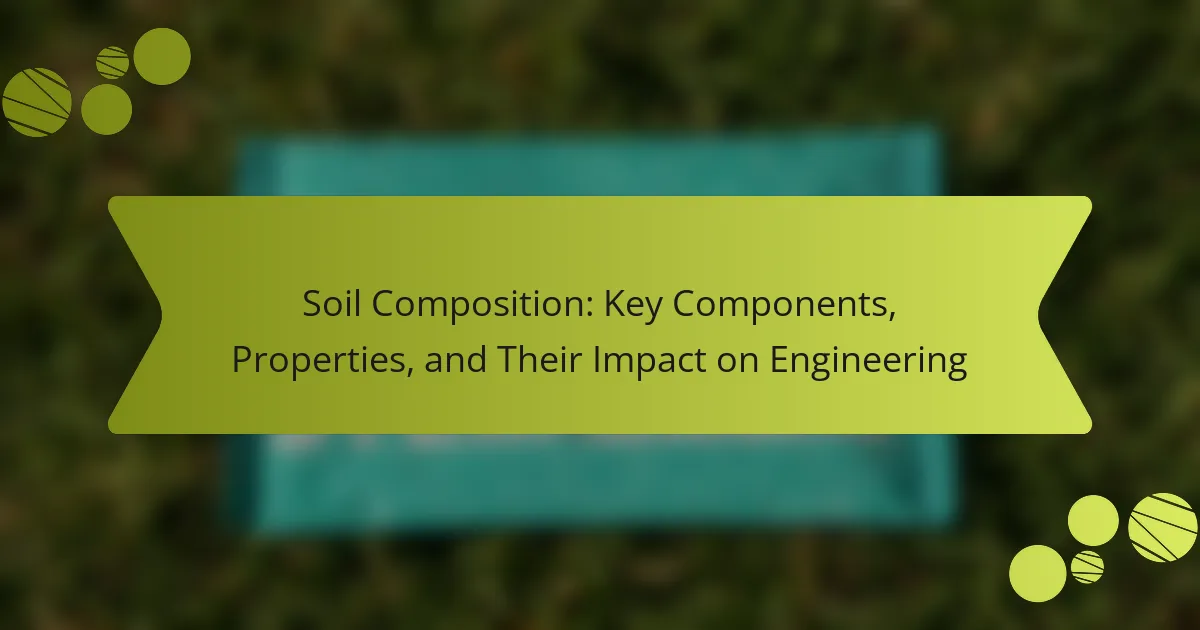Shear strength of soil is defined as the maximum resistance of soil to shear stress, a crucial parameter in geotechnical engineering. This strength is influenced by factors such as soil type, moisture content, and density, and is typically measured through methods like triaxial tests and direct shear tests. The Mohr-Coulomb failure criterion is commonly used to express shear strength for cohesive soils, relating it to cohesion and effective normal stress. Understanding these aspects is vital for assessing soil stability in construction projects, as they determine the soil’s ability to withstand shear forces and ensure structural integrity.

What is Shear Strength of Soil?
Shear strength of soil is the maximum resistance of soil to shear stress. It is a critical parameter in geotechnical engineering. This strength depends on factors such as soil type, moisture content, and density. The shear strength is typically measured using triaxial or direct shear tests. For cohesive soils, it can be expressed using the Mohr-Coulomb failure criterion. This criterion states that shear strength is a function of cohesion and the effective normal stress. The equation is τ = c + σ’ tan(φ). Here, τ represents shear strength, c is cohesion, σ’ is effective normal stress, and φ is the angle of internal friction. Understanding shear strength helps in assessing soil stability for construction projects.
How is shear strength defined in geotechnical engineering?
Shear strength in geotechnical engineering is defined as the maximum stress that soil can withstand before failure occurs. It is a crucial parameter for understanding soil behavior under loading conditions. Shear strength is influenced by factors such as cohesion and internal friction angle. Cohesion refers to the attractive forces between soil particles. The internal friction angle measures the resistance of soil to sliding along internal surfaces. Empirical models, such as the Mohr-Coulomb failure criterion, are often used to estimate shear strength. These models relate shear strength to normal stress and the aforementioned factors. Accurate assessment of shear strength is essential for safe and effective design in civil engineering projects.
What are the key components that contribute to shear strength?
The key components that contribute to shear strength are cohesion, internal friction angle, and normal stress. Cohesion refers to the attraction between soil particles, which enhances stability. The internal friction angle is the measure of resistance to sliding between particles. Normal stress affects the contact forces between particles, influencing shear strength. Together, these components determine how well soil can withstand shear forces. Research shows that increased cohesion and friction angle lead to higher shear strength, as evidenced by studies in geotechnical engineering.
How does shear strength relate to soil stability?
Shear strength is a critical factor in determining soil stability. It refers to the maximum resistance of soil to sliding or deformation. Higher shear strength indicates greater soil stability. This stability is essential for supporting structures and preventing landslides.
The shear strength of soil is influenced by factors such as cohesion and internal friction. Cohesion is the attractive force between soil particles. Internal friction arises from particle interactions during movement. Together, these factors contribute to the overall shear strength.
Research shows that soil with adequate shear strength can withstand external loads without failure. For example, a study by Terzaghi and Peck highlighted the importance of shear strength in foundation design. They emphasized that understanding shear strength is vital for predicting soil behavior under stress.
Why is shear strength important for construction projects?
Shear strength is crucial for construction projects because it determines the soil’s ability to resist sliding forces. High shear strength ensures stability for structures like buildings and bridges. It prevents failures such as landslides and foundation settling. Understanding shear strength helps engineers design safe and effective foundations. According to the Unified Soil Classification System, soils with adequate shear strength can support loads without excessive deformation. This characteristic is vital for the longevity and safety of construction projects. Therefore, assessing shear strength is a fundamental part of geotechnical engineering.
What role does shear strength play in foundation design?
Shear strength is crucial in foundation design as it determines the soil’s ability to resist sliding and failure. It influences the stability and load-bearing capacity of foundations. Higher shear strength indicates better support for structures. Engineers assess shear strength to prevent settlement and structural damage. The cohesion and internal friction angle of soil contribute to its shear strength. For example, cohesive soils exhibit higher shear strength when saturated. Testing methods like triaxial tests provide accurate shear strength values. These values guide the selection of foundation types and depths. Proper consideration of shear strength ensures long-lasting and safe structures.
How does shear strength influence soil behavior under load?
Shear strength significantly influences soil behavior under load. It determines the soil’s ability to resist sliding or failure when subjected to external forces. Higher shear strength indicates greater stability, allowing the soil to support heavier loads without deformation. Conversely, lower shear strength can lead to failure, resulting in landslides or structural instability.
Research indicates that shear strength is affected by factors such as soil composition, moisture content, and density. For example, saturated soils often exhibit reduced shear strength due to pore water pressure. The effective stress principle explains that shear strength is a function of the effective stress acting on the soil. This principle is critical in geotechnical engineering for predicting soil behavior under various loading conditions.

What factors influence the shear strength of soil?
The shear strength of soil is influenced by several key factors. These include soil composition, moisture content, and density. Soil composition affects the particle size and mineralogy, which determine inter-particle friction. Moisture content alters pore water pressure, impacting effective stress. Density influences the degree of compaction, affecting stability. Additionally, the presence of organic matter can reduce shear strength. The stress history of the soil, including previous loading and unloading, also plays a critical role. These factors collectively determine the soil’s ability to resist shear forces, making them essential for stability and performance assessments.
How do soil composition and structure affect shear strength?
Soil composition and structure significantly influence shear strength. Soil composition refers to the types and proportions of particles, such as sand, silt, and clay. Each type of particle has distinct properties affecting cohesion and friction. For example, clay particles contribute to higher cohesion due to their plate-like shape and electrostatic forces.
Soil structure relates to how these particles are arranged. Well-structured soils have stable aggregates that enhance shear strength. Poorly structured soils may exhibit weakness, leading to lower shear strength. Compacted soils typically show increased density and reduced voids, enhancing resistance to shear.
Research indicates that the Atterberg limits, which classify soil plasticity, correlate with shear strength. Higher plasticity often results in lower shear strength in saturated clays. Additionally, the effective stress principle shows that increased moisture reduces shear strength by decreasing inter-particle friction.
In summary, both soil composition and structure directly affect shear strength by influencing cohesion, friction, and overall stability of the soil matrix.
What are the effects of particle size and distribution on shear strength?
Particle size and distribution significantly affect shear strength in soils. Smaller particles generally increase the surface area, enhancing inter-particle friction and cohesion. This results in higher shear strength. Conversely, larger particles may lead to lower cohesion due to reduced contact points.
The distribution of particle sizes also plays a crucial role. Well-graded soils, containing a mix of particle sizes, tend to exhibit higher shear strength compared to poorly graded soils. This is because the smaller particles fill the voids between larger particles, improving packing and stability.
Research indicates that optimal particle size distribution can lead to a maximum dry density and increased shear strength. For example, studies show that a uniform particle size can lead to less effective load distribution, resulting in lower shear strength.
In summary, both particle size and distribution are critical in determining the shear strength of soils. Their influence is evident in various soil mechanics studies, highlighting the importance of these factors in engineering applications.
How does moisture content impact the shear strength of soil?
Moisture content significantly impacts the shear strength of soil. As moisture content increases, the effective stress within the soil decreases. This reduction in effective stress leads to a decrease in shear strength. When soil is saturated, pore water pressure increases, further reducing effective stress. Research indicates that the relationship between moisture content and shear strength is often non-linear. For example, a study found that clay soils exhibit marked reductions in shear strength with increasing moisture content. In contrast, sandy soils may show less sensitivity to moisture changes. The Atterberg limits, which relate to moisture content, also provide insight into soil behavior under varying moisture conditions. Thus, understanding moisture content is crucial for predicting soil stability and performance.
What environmental factors can alter shear strength?
Environmental factors that can alter shear strength include moisture content, temperature, and vegetation. Increased moisture can reduce shear strength by saturating soil and increasing pore water pressure. Conversely, dry conditions can enhance shear strength by reducing pore pressure. Temperature fluctuations can affect soil cohesion and friction angle. Vegetation impacts shear strength through root reinforcement, which stabilizes soil. Additionally, freeze-thaw cycles can disrupt soil structure, leading to decreased shear strength. These factors demonstrate the dynamic nature of shear strength in response to environmental changes.
How do temperature and weather conditions influence soil shear strength?
Temperature and weather conditions significantly influence soil shear strength. Higher temperatures can lead to increased evaporation, reducing soil moisture content. Dry soils typically exhibit lower cohesion, which decreases shear strength. Conversely, heavy rainfall can saturate soils, increasing pore water pressure. This saturation can weaken the soil structure, also leading to reduced shear strength. Seasonal temperature fluctuations may cause soil expansion and contraction. This process can create cracks and weaken the soil matrix. Research indicates that changes in moisture content and temperature directly correlate with variations in shear strength. For instance, studies show that saturated soils can lose up to 50% of their shear strength compared to dry conditions.
What is the impact of vegetation on soil stability and shear strength?
Vegetation significantly enhances soil stability and shear strength. Root systems of plants bind soil particles together. This binding reduces erosion and increases resistance to shear forces. Studies show that vegetation can improve soil cohesion by up to 30%. Additionally, the presence of vegetation increases water infiltration, reducing surface runoff. Enhanced water retention leads to a more stable soil structure. In forested areas, soil shear strength is often higher compared to bare soil. This is due to the organic matter and root networks that contribute to soil integrity. Overall, vegetation plays a crucial role in maintaining soil stability and enhancing its shear strength.

How can shear strength be measured and tested?
Shear strength can be measured and tested using various methods. Common techniques include the direct shear test, triaxial compression test, and unconfined compression test. The direct shear test involves applying a horizontal force to a soil specimen until failure occurs. This method provides a direct measurement of shear strength parameters.
The triaxial compression test subjects a cylindrical soil sample to controlled pressure and measures its response to shear stress. This test helps determine the effective stress parameters of the soil.
The unconfined compression test assesses the shear strength of cohesive soils without lateral confinement. It measures the maximum axial load a soil sample can withstand before failure.
These testing methods are standardized by organizations like ASTM (American Society for Testing and Materials). They provide reliable data for engineering applications.
What are the common methods for testing shear strength?
Common methods for testing shear strength include direct shear tests, triaxial tests, and unconfined compressive strength tests. The direct shear test measures shear strength by applying a horizontal force to a soil sample until failure occurs. Triaxial tests involve subjecting a cylindrical soil sample to controlled pressure and measuring its response under different conditions. Unconfined compressive strength tests assess the maximum axial load a soil can withstand without lateral support. These methods are widely used in geotechnical engineering to evaluate soil stability and performance.
How do direct shear tests differ from triaxial tests?
Direct shear tests and triaxial tests differ primarily in their approach to measuring soil shear strength. Direct shear tests apply a horizontal shear force to a soil sample, causing it to fail along a predetermined plane. This method provides a quick assessment of shear strength but does not account for the effects of confining pressure.
In contrast, triaxial tests involve subjecting a cylindrical soil sample to confining pressure while applying axial stress. This setup allows for a more comprehensive evaluation of soil behavior under various stress conditions. Triaxial tests can simulate different drainage conditions, providing insights into effective stress and pore water pressure.
The direct shear test is simpler and quicker, while the triaxial test offers more detailed information about soil strength under realistic conditions. The choice of test depends on the specific requirements of the engineering project.
What is the significance of the unconfined compressive strength test?
The unconfined compressive strength test is significant because it measures the strength of cohesive soils without any lateral confinement. This test provides critical information for assessing soil stability under various loading conditions. It helps engineers determine the load-bearing capacity of soil for construction projects. The results are essential for designing foundations, embankments, and other structures. The test is relatively simple and quick to perform, making it a practical choice for field and laboratory assessments. In geotechnical engineering, unconfined compressive strength values guide the selection of appropriate construction methods and materials. For example, clay soils often exhibit varying strengths, which can impact slope stability and earthworks. Thus, understanding these values is vital for ensuring safety and performance in engineering applications.
What best practices can be followed to ensure accurate shear strength measurements?
To ensure accurate shear strength measurements, it is crucial to follow standardized testing procedures. Consistent sample preparation is essential. This includes maintaining uniform moisture content and avoiding disturbance during sampling. Proper equipment calibration must be conducted before testing. This ensures that the measurements reflect true material properties. Environmental conditions should be controlled during testing. Fluctuations in temperature and humidity can affect results. Multiple tests should be conducted to verify consistency. Statistical analysis of results enhances reliability. Adhering to guidelines from organizations like ASTM or ISO provides a framework for accuracy. These practices collectively lead to more reliable shear strength data.
How can soil sampling techniques affect test results?
Soil sampling techniques can significantly affect test results by influencing the accuracy and representativeness of the data collected. Different methods, such as grab sampling or composite sampling, can yield varying results due to differences in soil composition. For instance, grab sampling may reflect localized variations, while composite sampling averages multiple locations, potentially masking critical variations. The depth and location of sampling also play a crucial role; samples taken from different depths can exhibit different shear strengths. Additionally, the timing of sampling, such as wet versus dry conditions, can alter the moisture content and, consequently, the test results. Research indicates that inconsistent sampling techniques can lead to misleading conclusions about soil stability, affecting engineering decisions. Therefore, standardized sampling methods are essential for reliable soil analysis.
What precautions should be taken during shear strength testing?
Precautions during shear strength testing include ensuring proper sample preparation. Samples should be undisturbed and representative of the field conditions. Equipment calibration is essential for accurate measurements. The testing environment must be controlled to avoid temperature and humidity effects. Operators should follow standardized testing procedures to maintain consistency. Safety measures must be in place to protect personnel from equipment hazards. Proper documentation of test conditions and results is crucial for repeatability. Following these precautions enhances the reliability of shear strength test outcomes.
What strategies can improve soil shear strength in engineering applications?
Soil shear strength can be improved through various engineering strategies. These include soil compaction, which increases density and reduces voids. The addition of stabilizing agents, such as lime or cement, can enhance the cohesion of soil. Implementing drainage systems helps manage water content, reducing pore pressure and increasing effective stress. Reinforcement techniques, like geogrids or soil nails, provide additional support and improve shear resistance.
Soil replacement with stronger materials can also be an effective strategy. Utilizing proper grading and slope design minimizes erosion and instability. Each of these methods has been supported by engineering principles and field studies demonstrating their effectiveness in enhancing soil shear strength.
Shear strength of soil is defined as the maximum resistance of soil to shear stress, a critical parameter in geotechnical engineering that influences soil stability and performance. This article explores the factors affecting shear strength, including soil composition, moisture content, and density, as well as the key components such as cohesion and internal friction angle. Various testing methods, including direct shear and triaxial tests, are discussed to measure shear strength accurately. Additionally, the article highlights the importance of shear strength in construction projects and foundation design, emphasizing its role in preventing structural failures and ensuring safety.
